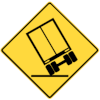 I've noticed something that concerns me in my travels lately, and that is the single long, narrow, curved tire marks that begin about two thirds of the way into a corner and end when the curve does. They don't appear in the traffic lane in the lateral position that one would expect of a vehicle travelling where it should either. These are weight shift marks and indicate a heavy transport truck on the edge of a tip over.
I've noticed something that concerns me in my travels lately, and that is the single long, narrow, curved tire marks that begin about two thirds of the way into a corner and end when the curve does. They don't appear in the traffic lane in the lateral position that one would expect of a vehicle travelling where it should either. These are weight shift marks and indicate a heavy transport truck on the edge of a tip over.
Heavy Trucks Tip Over
Heavy trucks are a different sort of beast when it comes to travelling around a corner. In your car or light truck if you travel into the curve at too high a speed you begin to yaw because there is not sufficient friction available to stick your tires to the road and force your vehicle to follow the curve.
Heavy trucks have a much higher centre of mass and are acted on differently by the forces encountered in the curve. Before their tires lose traction on the road surface the forces through the centre of mass are sufficient to tip the combination over, starting at the rear end.
Video Example of Tip Over
How the Tire Marks are Made
When this occurs, tremendous forces act on the last set of tires that are on the outside of the curve. The heat generated between the tire and road surface leaves the characteristic tire marks that I am talking about. Often these marks appear either further to the right than usual, or in the oncoming lane, perhaps indicating that the driver is not attempting to keep proper lane position to start with.
Tip Over Speed Calculations
Collision reconstruction will make use of these marks in the tipover formula to calculate the speed of the truck. Evidence required from the collision scene needed is the radius of curvature (r) of the mark, the track width of the trailer (b), the height of the trailer center of mass (h) and the gravitational constant (g).

Using the radius of the curve for the outside tire in it's proper lane position instead of the mark results in the maximum speed for that vehicle to safely negotiate the corner.
The Driver Was Lucky
If you don't find the truck laying on it's side at the end of these marks you know that it has been driven around the curve on the ragged edge of tipping over, but the driver and other road users have been lucky, this time.
I've been on the outside of the curve once in my service, and watching that truck heading for me with the white smoke pouring off the edges of the outside tires is an experience I hope you never share.
Reporting Commercial Vehicle Violations
To report commercial vehicle safety violations, call your nearest police detachment or Commercial Vehicle Safety and Enforcement (CVSE) at 1-888-775-8785 (province wide).
Learn More
Tipping Heavy Trucks Over on Purpose
Share This Article
I'm no mathematician, but that was an informative item on trucks and traction, and so on.
I've heard that one of the 'dodgiest' loads to haul is a reefer full of cow carcasses, all hanging from hooks at the top of the trailer. That's gotta be the worst, when it comes to a high centre of gravity, eh?
That video reminded me of the logging truck that tipped on Hwy 1 back in 2004, westbound just after Capilano Road. The fact is, that particular bridge/curve is an awful piece of engineering that has caused many drivers to lose control of their vehicles over the last 60+ years. They keep trying to 'fix' it with barriers and lights and signs and so on, but the government of the day always prefers to delaying the necessary restructuring of that section of the highway.
- Log in to post comments
I would like to know who is passing drivers for the class 1 with air. I cannot believe the ignorance shown from drivers who are trusted to handle the (in most cases) largest vehicle on the road. I truly believe they left their brains at home. The training and the testing is not nearly tough enough. Maybe the trainers should put their loved ones (hypothetically) on the same highway as these so called class one truck drivers and I'm sure they would demand some changes. Probably save many lives and costly damage.
- Log in to post comments
ICBC has set Mandatory Entry Level Training (MELT) for class 1 licensed drivers. This is a recent development and it remains to be seen how much of an improvement it produces.
- Log in to post comments
- Log in to post comments

Very informative!